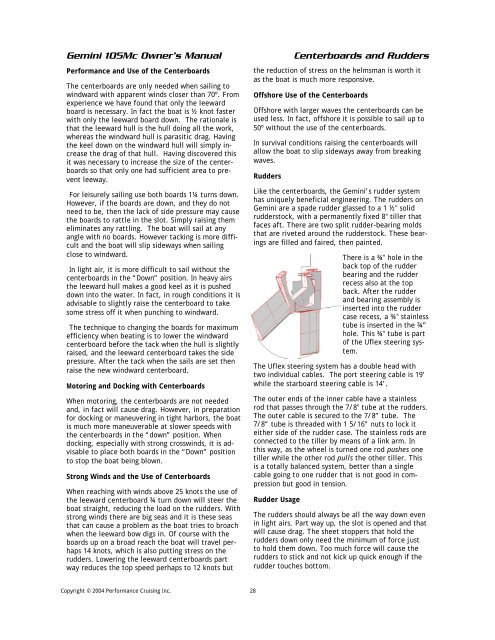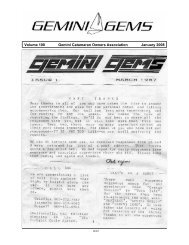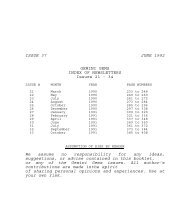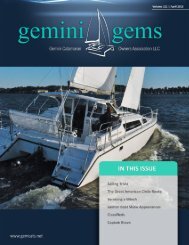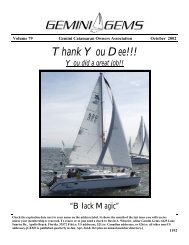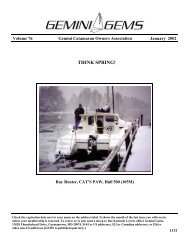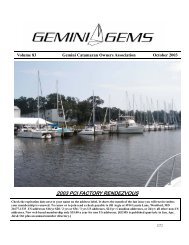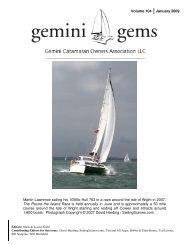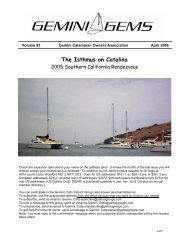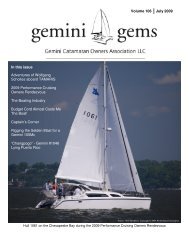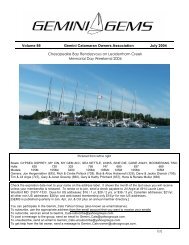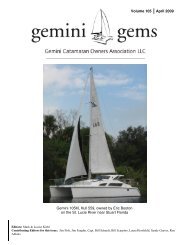Gemini Owners Manual.pub - Gemini Gems
Gemini Owners Manual.pub - Gemini Gems
Gemini Owners Manual.pub - Gemini Gems
You also want an ePaper? Increase the reach of your titles
YUMPU automatically turns print PDFs into web optimized ePapers that Google loves.
<strong>Gemini</strong> 105Mc Owner’s <strong>Manual</strong><br />
Performance and Use of the Centerboards<br />
The centerboards are only needed when sailing to<br />
windward with apparent winds closer than 70º. From<br />
experience we have found that only the leeward<br />
board is necessary. In fact the boat is ½ knot faster<br />
with only the leeward board down. The rationale is<br />
that the leeward hull is the hull doing all the work,<br />
whereas the windward hull is parasitic drag. Having<br />
the keel down on the windward hull will simply increase<br />
the drag of that hull. Having discovered this<br />
it was necessary to increase the size of the centerboards<br />
so that only one had sufficient area to prevent<br />
leeway.<br />
For leisurely sailing use both boards 1¼ turns down.<br />
However, if the boards are down, and they do not<br />
need to be, then the lack of side pressure may cause<br />
the boards to rattle in the slot. Simply raising them<br />
eliminates any rattling. The boat will sail at any<br />
angle with no boards. However tacking is more difficult<br />
and the boat will slip sideways when sailing<br />
close to windward.<br />
In light air, it is more difficult to sail without the<br />
centerboards in the “Down” position. In heavy airs<br />
the leeward hull makes a good keel as it is pushed<br />
down into the water. In fact, in rough conditions it is<br />
advisable to slightly raise the centerboard to take<br />
some stress off it when punching to windward.<br />
The technique to changing the boards for maximum<br />
efficiency when beating is to lower the windward<br />
centerboard before the tack when the hull is slightly<br />
raised, and the leeward centerboard takes the side<br />
pressure. After the tack when the sails are set then<br />
raise the new windward centerboard.<br />
Motoring and Docking with Centerboards<br />
When motoring, the centerboards are not needed<br />
and, in fact will cause drag. However, in preparation<br />
for docking or maneuvering in tight harbors, the boat<br />
is much more maneuverable at slower speeds with<br />
the centerboards in the “down” position. When<br />
docking, especially with strong crosswinds, it is advisable<br />
to place both boards in the “Down” position<br />
to stop the boat being blown.<br />
Strong Winds and the Use of Centerboards<br />
When reaching with winds above 25 knots the use of<br />
the leeward centerboard ¾ turn down will steer the<br />
boat straight, reducing the load on the rudders. With<br />
strong winds there are big seas and it is these seas<br />
that can cause a problem as the boat tries to broach<br />
when the leeward bow digs in. Of course with the<br />
boards up on a broad reach the boat will travel perhaps<br />
14 knots, which is also putting stress on the<br />
rudders. Lowering the leeward centerboards part<br />
way reduces the top speed perhaps to 12 knots but<br />
Centerboards and Rudders<br />
the reduction of stress on the helmsman is worth it<br />
as the boat is much more responsive.<br />
Offshore Use of the Centerboards<br />
Offshore with larger waves the centerboards can be<br />
used less. In fact, offshore it is possible to sail up to<br />
50º without the use of the centerboards.<br />
In survival conditions raising the centerboards will<br />
allow the boat to slip sideways away from breaking<br />
waves.<br />
Rudders<br />
Like the centerboards, the <strong>Gemini</strong>’s rudder system<br />
has uniquely beneficial engineering. The rudders on<br />
<strong>Gemini</strong> are a spade rudder glassed to a 1 ½" solid<br />
rudderstock, with a permanently fixed 8" tiller that<br />
faces aft. There are two split rudder-bearing molds<br />
that are riveted around the rudderstock. These bearings<br />
are filled and faired, then painted.<br />
There is a ¾" hole in the<br />
back top of the rudder<br />
bearing and the rudder<br />
recess also at the top<br />
back. After the rudder<br />
and bearing assembly is<br />
inserted into the rudder<br />
case recess, a ¾" stainless<br />
tube is inserted in the ¾”<br />
hole. This ¾" tube is part<br />
of the Uflex steering system.<br />
The Uflex steering system has a double head with<br />
two individual cables. The port steering cable is 19’<br />
while the starboard steering cable is 14’.<br />
The outer ends of the inner cable have a stainless<br />
rod that passes through the 7/8" tube at the rudders.<br />
The outer cable is secured to the 7/8” tube. The<br />
7/8” tube is threaded with 1 5/16” nuts to lock it<br />
either side of the rudder case. The stainless rods are<br />
connected to the tiller by means of a link arm. In<br />
this way, as the wheel is turned one rod pushes one<br />
tiller while the other rod pulls the other tiller. This<br />
is a totally balanced system, better than a single<br />
cable going to one rudder that is not good in compression<br />
but good in tension.<br />
Rudder Usage<br />
The rudders should always be all the way down even<br />
in light airs. Part way up, the slot is opened and that<br />
will cause drag. The sheet stoppers that hold the<br />
rudders down only need the minimum of force just<br />
to hold them down. Too much force will cause the<br />
rudders to stick and not kick up quick enough if the<br />
rudder touches bottom.<br />
Copyright © 2004 Performance Cruising Inc.<br />
28


